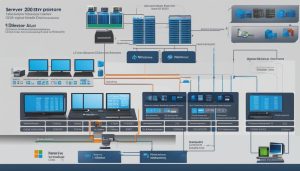Welcome to my insightful guide on Windows NT 3.5! In this article, I will take you through the history, features, system requirements, updates, and documentation of this pivotal operating system developed by Microsoft. Whether you’re a tech enthusiast or someone curious about the evolution of operating systems, this guide will provide you with a comprehensive understanding of Windows NT 3.5.
Released in September 1994 as an upgrade to Windows NT 3.1, Windows NT 3.5 brought significant improvements to the architecture and functionality of the operating system. It introduced a new user interface, enhanced networking capabilities, improved security features, and support for 32-bit hardware and preemptive multitasking. It paved the way for future versions of Windows NT and the Windows Server family, making it an important milestone in the world of business computing.
Throughout this guide, I will delve into the features and tools that Windows NT 3.5 offered, such as Active Directory, Group Policy, Remote Desktop, and Hyper-V. Additionally, I will discuss the system requirements for successful installation and operation, as well as the updates and hotfixes released by Microsoft to enhance performance and address vulnerabilities.
Furthermore, I will highlight the comprehensive documentation available for Windows NT 3.5, which covers installation, configuration, and administration of the operating system. This resource is invaluable for users and administrators alike, providing detailed guidance on various aspects of Windows NT 3.5.
Lastly, I will explore the security features that Windows NT 3.5 implemented to protect against unauthorized access and maintain the integrity of the operating system. From secure login facilities to discretionary access control and auditing capabilities, Windows NT 3.5 was designed with security in mind.
Key Takeaways:
- Windows NT 3.5 was a pivotal operating system released by Microsoft in September 1994.
- It introduced improvements to architecture, functionality, and security.
- Windows NT 3.5 laid the foundation for future versions and the Windows Server family.
- It offered features like Active Directory, Group Policy, Remote Desktop, and Hyper-V.
- The system requirements included a minimum of 8 MB of RAM and 100 MB of disk space.
Windows NT 3.5 Features and Tools
Windows NT 3.5 introduced several groundbreaking features and tools that revolutionized the functionality and management of the operating system.
Active Directory
One of the key additions to Windows NT 3.5 was Active Directory, a powerful directory service that provided administrators with the ability to manage and organize network resources seamlessly. Active Directory introduced a hierarchical structure that allowed for efficient management of users, groups, computers, and other network objects.
Group Policy
Another notable feature in Windows NT 3.5 was Group Policy, which allowed administrators to define and enforce rules and policies for user access and program usage. This feature provided centralized control over various aspects of the operating system, such as security settings, application configurations, and desktop environment preferences.
Remote Desktop and Hyper-V
Windows NT 3.5 also introduced tools like Remote Desktop and Hyper-V, which greatly enhanced remote management capabilities and enabled the creation of virtual environments. Remote Desktop allowed users to access their Windows NT 3.5 machines from remote locations, facilitating collaboration and flexibility. Hyper-V, on the other hand, enabled the creation and management of virtual machines, paving the way for virtualization technology.
The inclusion of these features and tools made Windows NT 3.5 a powerful and versatile operating system, particularly suited for corporate and enterprise environments. These advancements laid the foundation for future versions of Windows NT and shaped the evolution of the Windows Server family.
| Feature | Description |
|---|---|
| Active Directory | A hierarchical directory service for efficient resource management on networks. |
| Group Policy | Enables centralized control over user access, program usage, and system configurations. |
| Remote Desktop | Allows remote access to Windows NT 3.5 machines, promoting collaboration and flexibility. |
| Hyper-V | Enables the creation and management of virtual machines, facilitating virtualization. |
Windows NT 3.5 History and Legacy
Windows NT 3.5 was a significant milestone in the evolution of the Windows NT operating system. It was released in September 1994 as an upgrade to Windows NT 3.1, introducing improvements in architecture, performance, and security. The release of Windows NT 3.5 marked a turning point for Microsoft, laying the foundation for future versions of the operating system and paving the way for the development of the Windows Server family.
The legacy of Windows NT 3.5 can be seen in subsequent releases such as Windows NT 4.0 and Windows 2000, which built upon the advancements made in version 3.5. These later versions expanded the capabilities and features introduced in Windows NT 3.5, further solidifying its impact on the computing world.
Despite no longer being actively supported by Microsoft, the influence of Windows NT 3.5 can still be felt in modern operating systems. Its scalable and flexible architecture, along with its robust security features, made it a popular choice for corporate and enterprise environments during its time. The advancements made in Windows NT 3.5 set the stage for the development of more sophisticated operating systems, shaping the future of computing.
Windows NT 3.5 Legacy
The legacy of Windows NT 3.5 extends beyond its technical achievements. It revolutionized the way businesses approached computing, providing a stable and secure platform for critical operations. The introduction of Windows NT 3.5 paved the way for the widespread adoption of Windows-based servers in enterprise environments.
The impact of Windows NT 3.5 on the business world cannot be overstated. It set new standards for reliability, performance, and security, laying the groundwork for the modern server infrastructure we have today. The principles established by Windows NT 3.5 continue to be the foundation of Microsoft’s server operating systems, enabling organizations to build and maintain scalable and secure IT infrastructures.
In conclusion, Windows NT 3.5’s history and legacy are intertwined with the evolution of the Windows NT operating system and the success of the Windows Server family. While newer versions have superseded it, Windows NT 3.5 remains a significant milestone in the history of computing, shaping the future of operating systems and leaving an indelible mark on the industry.
Windows NT 3.5 System Requirements
Before installing Windows NT 3.5, it’s important to ensure that your system meets the necessary requirements for optimal performance and stability. Here are the system requirements you need to consider:
- Memory (RAM): A minimum of 8 MB of RAM is required to run Windows NT 3.5 smoothly. However, it is recommended to have more RAM for better performance, especially if you plan to run multiple applications simultaneously.
- Storage Space: Windows NT 3.5 requires at least 100 MB of available disk space for installation. Additional space is needed for system updates, applications, and user data. Therefore, it’s advisable to have a larger hard drive to accommodate future requirements.
- Processor: Windows NT 3.5 supports 32-bit x86 processors. It is essential to have a compatible processor to ensure compatibility and optimal performance.
Windows NT 3.5 is designed to work with a variety of hardware configurations, including networking devices, printers, and storage devices. Its versatility allows it to be deployed on both desktop and server-class machines, making it suitable for various environments.
By meeting the system requirements, you can ensure a smooth installation and operation of Windows NT 3.5, enabling you to take full advantage of its powerful features and functionality.
| System Requirement | Minimum Specification |
|---|---|
| Memory (RAM) | 8 MB |
| Storage Space | 100 MB |
| Processor | 32-bit x86 |
Windows NT 3.5 Updates and Hotfixes
Windows NT 3.5, like any other operating system, received regular updates and hotfixes from Microsoft to address various issues, vulnerabilities, and improve the overall performance. These updates were crucial in ensuring the stability and security of Windows NT 3.5 installations.
Microsoft released updates and hotfixes periodically, making them available for download from their website. These updates included bug fixes, security patches, and enhancements that addressed specific issues identified by Microsoft or reported by users. By regularly installing these updates, users could keep their Windows NT 3.5 systems up-to-date with the latest improvements and security measures.
It’s important to note that while Windows NT 3.5 is no longer actively supported by Microsoft, the updates and hotfixes released during its lifecycle played a significant role in optimizing the operating system’s performance and addressing potential vulnerabilities. Therefore, it is recommended for users who still rely on Windows NT 3.5 to ensure that they have installed all available updates to maintain a secure and stable system.
| Date | Update | Description |
|---|---|---|
| October 1994 | Update 1 | Addresses issues related to network connectivity and stability. |
| December 1994 | Hotfix 1 | Fixes a critical security vulnerability in the operating system’s TCP/IP stack. |
| February 1995 | Update 2 | Enhances the performance of file sharing and improves memory management. |
These updates and hotfixes played a crucial role in keeping Windows NT 3.5 secure and reliable, ensuring that users could make the most of the operating system’s capabilities. By regularly checking for and installing updates, users could benefit from the ongoing improvements and enhancements released by Microsoft.
Windows NT 3.5 Documentation
Windows NT 3.5 documentation provides comprehensive information on the installation, configuration, and administration of the operating system. It serves as a valuable resource for users and administrators to understand and maximize the capabilities of Windows NT 3.5. The documentation includes user guides, administrator’s manuals, and technical reference materials, covering a wide range of topics.
Table: Windows NT 3.5 Documentation Topics
| Documentation Topics | Description |
|---|---|
| Installation Guide | Step-by-step instructions on installing Windows NT 3.5 on different hardware configurations. |
| Configuration Guide | Guidelines for configuring networking options, hardware peripherals, and system settings. |
| User Account Management | Information on creating, managing, and securing user accounts and permissions. |
| Network Administration | Techniques for setting up and managing network services, such as file sharing, printing, and remote access. |
| Troubleshooting | Tips and solutions for resolving common issues and errors encountered during system operation. |
The Windows NT 3.5 documentation also includes in-depth explanations of advanced topics, such as domain management, system performance optimization, and security configuration. It provides detailed instructions on utilizing the various features and tools available in Windows NT 3.5, empowering users and administrators to make the most of the operating system’s capabilities.
Whether you are a beginner seeking guidance on initial setup or an experienced administrator looking to fine-tune your system, the Windows NT 3.5 documentation offers comprehensive insights and instructions to help you effectively manage and utilize your Windows NT 3.5 environment.
Windows NT 3.5 Security Features
Windows NT 3.5 incorporated robust security features to protect against unauthorized access and maintain the integrity of the operating system. One of the key security measures implemented was the secure logon facility, which required users to enter a unique identifier and password to gain access to the computer. This added an extra layer of protection and ensured that only authorized individuals could access the system.
In addition to secure logon, Windows NT 3.5 also employed discretionary access control (DAC). DAC allowed administrators to define and enforce access permissions for resources such as files, folders, and network shares. By implementing DAC, administrators had granular control over who could access specific resources, reducing the risk of unauthorized data breaches.
Windows NT 3.5 further enhanced its security capabilities by including auditing capabilities. Auditing allowed administrators to monitor and record user access attempts and actions taken on the system. This feature provided valuable insights into potential security threats and helped organizations identify and address any vulnerabilities in their infrastructure.
Key Security Features:
- Secure logon facility requiring unique identifier and password
- Discretionary access control (DAC) for granular access permissions
- Auditing capabilities to monitor user access and actions
With its robust security features, Windows NT 3.5 earned a C2 security rating, making it a trusted choice for businesses and organizations seeking a secure operating system.
By incorporating these security features, Windows NT 3.5 provided a secure foundation for businesses and organizations to operate and protect their sensitive data. The combination of secure logon, discretionary access control, and auditing capabilities ensured that only authorized users had access to critical resources, minimizing the risk of data breaches and unauthorized system modifications.
The emphasis on security in Windows NT 3.5 paved the way for subsequent versions of the Windows NT operating system, setting a precedent for the importance of robust security measures in modern operating systems.
Table 1: Windows NT 3.5 Security Features Overview
| Security Feature | Description |
|---|---|
| Secure Logon Facility | Requires unique identifier and password for system access |
| Discretionary Access Control (DAC) | Defines and enforces access permissions for resources |
| Auditing Capabilities | Monitors and records user access attempts and actions |
Conclusion
In conclusion, Windows NT 3.5 was a groundbreaking operating system developed by Microsoft that brought significant improvements to the world of computing. With its release in September 1994, Windows NT 3.5 revolutionized the architecture, functionality, and security of operating systems. It introduced a new user interface, enhanced networking capabilities, and support for 32-bit hardware, making it a powerful choice for businesses and organizations.
Although Windows NT 3.5 is no longer actively supported by Microsoft, its impact on the computing industry cannot be underestimated. It laid the foundation for subsequent versions of the Windows NT operating system, including Windows NT 4.0 and Windows 2000, which further built upon its advancements. The legacy of Windows NT 3.5 can also be seen in the development of the Windows Server family, which continues to be a dominant force in the business computing world.
With its scalability, flexibility, and robust security features, Windows NT 3.5 set a new standard for operating systems. It received regular updates and hotfixes from Microsoft to address issues and vulnerabilities, ensuring the stability and security of the system. The comprehensive documentation provided valuable resources for users and administrators to maximize the capabilities of Windows NT 3.5.
While Windows NT 3.5 may have faded into the background, its influence is still felt in the development of modern operating systems. The advancements made in Windows NT 3.5 have paved the way for a new era of computing, where security, functionality, and user experience are paramount.
FAQ
What is Windows NT 3.5?
Windows NT 3.5 is a pivotal operating system developed by Microsoft, released in September 1994 as an upgrade to Windows NT 3.1.
What are the features of Windows NT 3.5?
Windows NT 3.5 introduced a new user interface, enhanced networking capabilities, improved security features, and support for 32-bit hardware and preemptive multitasking.
When was Windows NT 3.5 released?
Windows NT 3.5 was released in September 1994.
What is the architecture of Windows NT 3.5?
Windows NT 3.5 introduced significant improvements to the architecture and functionality of the operating system.
What are the system requirements for Windows NT 3.5?
Windows NT 3.5 requires a minimum of 8 MB of RAM and 100 MB of available disk space.
Are there updates available for Windows NT 3.5?
Yes, Microsoft released updates and hotfixes for Windows NT 3.5 to address various issues and vulnerabilities.
Where can I find documentation for Windows NT 3.5?
Windows NT 3.5 documentation provides detailed information on installation, configuration, and administration of the operating system.
What security features does Windows NT 3.5 offer?
Windows NT 3.5 implemented a secure logon facility, discretionary access control, and auditing capabilities to ensure security.
What is the legacy of Windows NT 3.5?
Windows NT 3.5 laid the foundation for future versions of the Windows NT operating system and the Windows Server family.
Janina is a senior specialist in information technology


